towing PONTIAC PONTIAC 1996 Owners Manual
[x] Cancel search | Manufacturer: PONTIAC, Model Year: 1996, Model line: PONTIAC, Model: PONTIAC PONTIAC 1996Pages: 370, PDF Size: 17.69 MB
Page 79 of 370

New Vehicle 66Break-InS’ Ignition Positions
Your modern Pontiac doesn’t need an elaborate
“break-in.” But
it will perform better in the long
run
if you follow these guidelines:
Don’t drive at any one speed
-- fast or
slow
-- for the first 500 miles (804 km).
Don’t make full-throttle starts.
Avoid making hard stops for the first
200 miles (322 km) or so. During this time
your new brake linings aren’t
yet broken
in. Hard stops with new linings can mean
premature wear and earlier replacement.
Follow this breaking-in guideline every
time
you get new brake linings.
Don’t tow a trailer during break-in, See
‘‘Towing a Trailer’’ in the Index for more
information.
C
A i E
With the ignition key in the ignition switch, you can twn
the switch to five positions.
ACC (A): This position lets you use things like the
radio and windshield wipers when the engine is
off. To
use ACC (Accessory), push in the key and turn it toward
you. Your steering wheel will stay locked.
LOCK (B): Before you put the key into the ignition
switch, the switch
is in the LOCK position. It’s also the
only position in which you can remove your key.
This
position locks your ignition, steering wheel and
transaxle. It’s a theft-deterrent feature.
ProCarManuals.com
Page 81 of 370
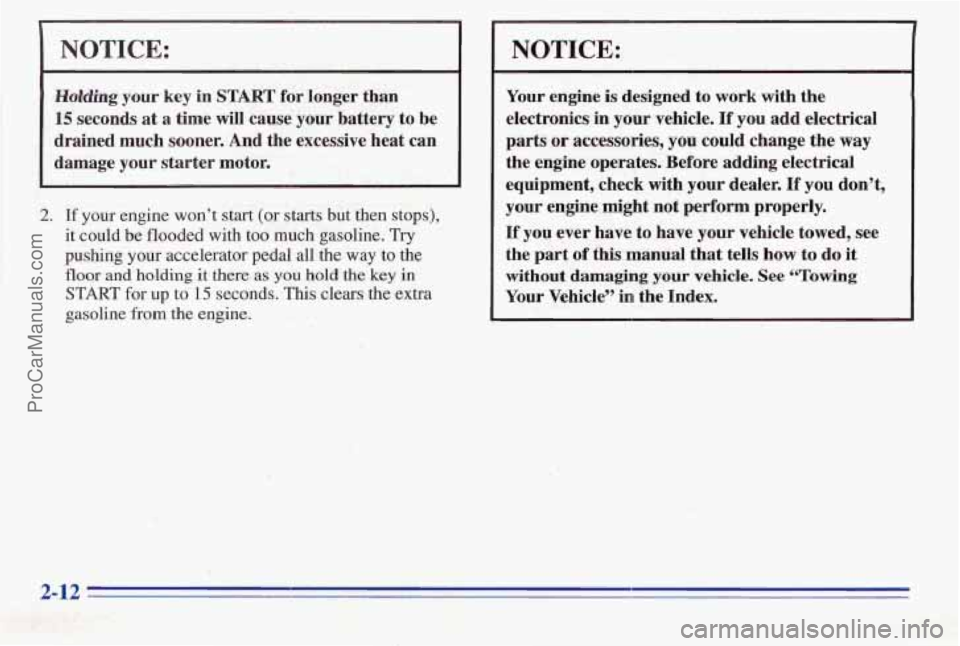
NOTICE:
Hdding your key in START for longer than
15 seconds at a time will cause your battery to be
drained much sooner. And the excessive heat can
damage your starter motor.
2. If your engine won’t start (or starts but then stops),
it could be flooded with too
much gasoline. Try
pushing your accelerator pedal all the way to the
floor and holding it there as you hold the key in
START for up to 15 seconds. This clears the extra
gasoline from the engine.
4
NOTICE:
Your engine is designed to work with the
electronics in your vehicle.
If you add electrical
parts
or accessories, you could change the way
the engine operates. Before adding electrical
equipment, check with
your dealer. If you don’t,
your engine might not perform properly.
If’ you ever have to have your vehicle towed, see
the part
of this manual that tells how to do it
without damaging your vehicle. See “Towing
Your Vehicle” in the Index.
2-12
ProCarManuals.com
Page 85 of 370
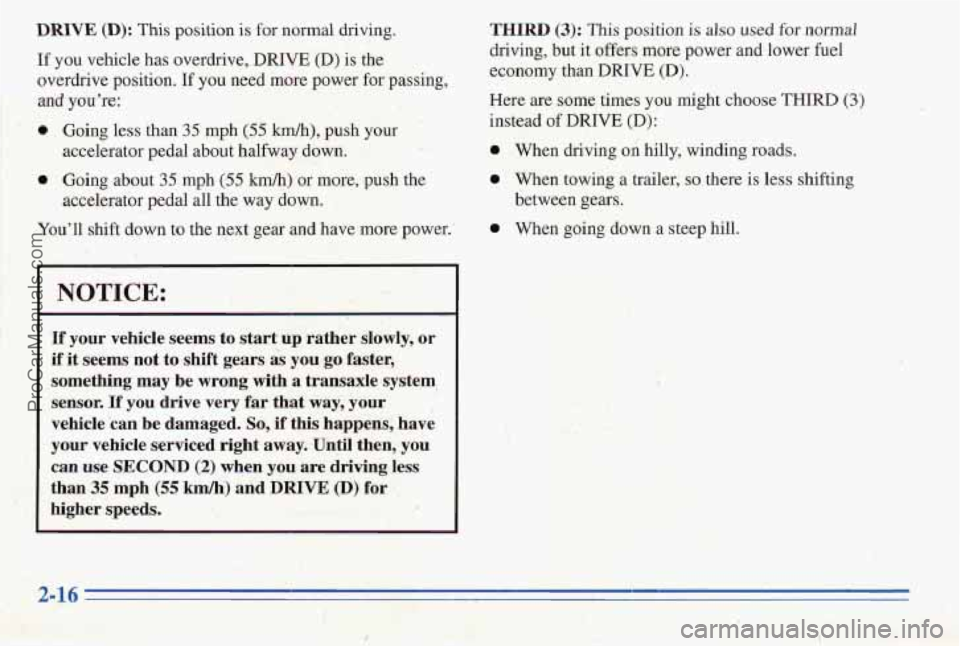
DRIVE (D): This position is for normal driving.
If you vehicle has overdrive, DRIVE (D) is the
overdrive position. If you need more power for passing,
0 Going less than 35 mph (55 km/h), push your
0 Going about 35 mph (55 kmk) or more, push the
You'll shift down to the next
gear and have more power.'
and you":
accelerator pedal about halfway down.
accelerator pedal all the way down.
THIRD (3): This position is also used for normal
driving, but
it offers more power and lower fuel
economy than
DRIVE (D).
Here are some times you might choose THIRD (3)
instead of DRIVE (D):
0 . When driving on hilly, winding roads.
0 When towing a trailer, so there is less shifting
0 When going down a steep hill.
between gears.
NOTICE:
'If your vehicle seems to startup rather slowly, or
if it seems
not to.sMft gears is you go faster,
something may be wrong with
a transaxle system
,sensor. If you drive very far that way, your
vehicle can
be damaged. So, if this happens; have
your vehicle serviced right away. Until'then,
you
can use SECOND (2) when you are driving less
than
35 mph (55 kmh) and DRn7E (D) for
higher speeds.
ProCarManuals.com
Page 88 of 370
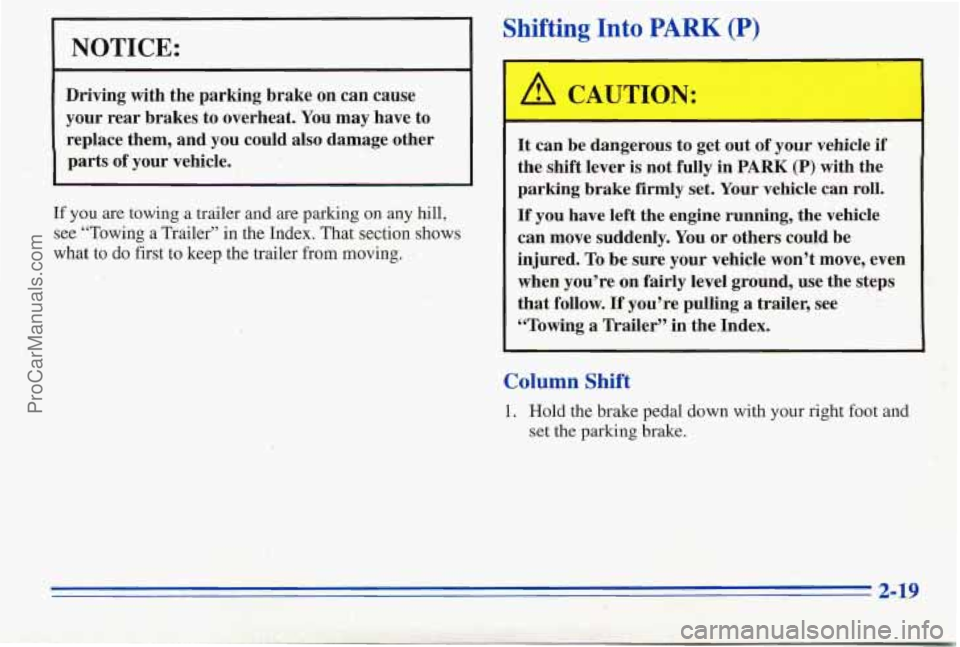
Shifting Into PARK (P)
NOTICE:
Driving with the parking brake on can cause
your rear brakes to overheat. You may have to
replace them, and you could also damage other
parts of your vehicle.
If
you are towing a trailer and are parking on any hill,
see "Towing a Trailer" in the Index. That section shows
what to do first
to keep the trailer from moving.
L
e dangerous to get out of your vehicle if
the shift. lever is not fully in
PARK (P) with the
parking brake firmly
set. Your vehicle can roll.
If you have left the engine running, the vehicle
can move suddenly.
You or others could be
injured.
TO be sure your vehicle won't move, even
when you're on
fairly level ground, use the steps
that follow.
If you're pulling a trailer, see
"Towing a Trailer'' in the Index.
Column Shift
1. Hold the brake pedal down with your right foot and
set the
parking brake.
ProCarManuals.com
Page 93 of 370
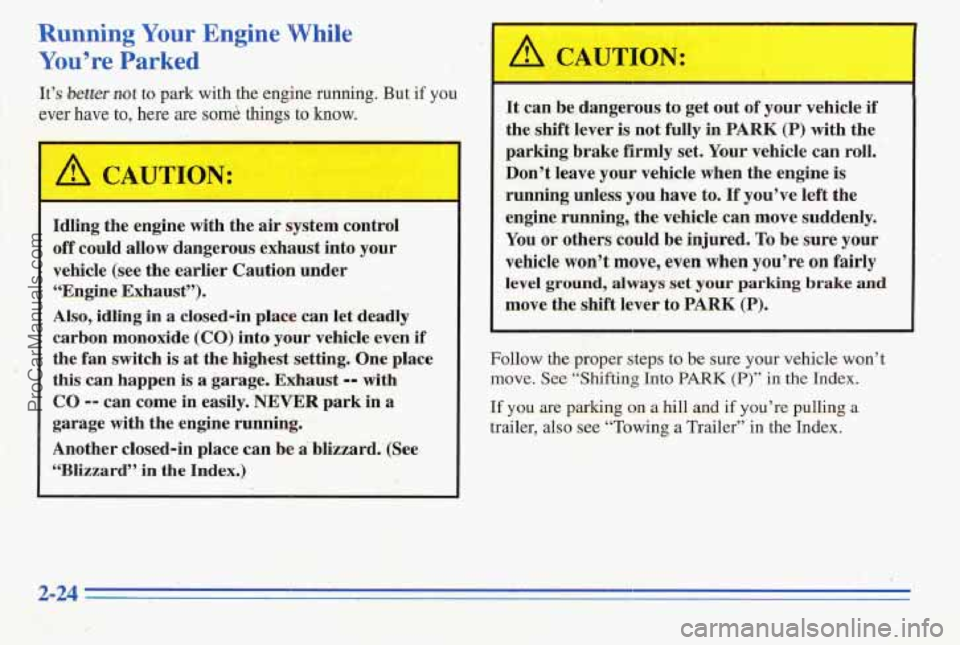
Running Your Engine While
You’re Parked
It’s bewr not to park with the engine ruanhig. But if you
ever have to, here are some things to know.
:- I .. .,
Idling the engine. with the air system control
off could allow dangerous exhaust into yo,ur
vehide (see the earlier Caution under
“Engine Exhalast”).
Also, idling in
a closed-in place can let deadly
carbon monoxide (CO) into your vehicle even if
the fan switch
is at the highest setting. \One place
this an happen is a garage. Exhanst -- with
CO -- can come in easily. park in a
garage with. the engine running.
Another closed-in place can be
a blizzard: (See
‘CBlizzard”
in the Index.)
It can be. dangerous to get out of your vehicle if
the shift lever is not fully in PARK (P) with the
parking brake firmly set. Your vehicle can roll.
Don’t leave your vehicle when the engine
is
running unless you have to. If you’ve left the
engine running, the vehicle can move suddenly.
You or others could be injured.
To besure your
vehicle
won’t move, even when you’re on fairly
level ground, always set your parking brake and
.move the shift lever to Pm (P).
Follow the proper steps to be sure your vehicle won’t
move. See “Shifting Into PARK (P)” in the Index.
If you are parking on a hill and if you’re pulling a
trailer, also see “Towing a Trailer” in the Index.
ProCarManuals.com
Page 117 of 370
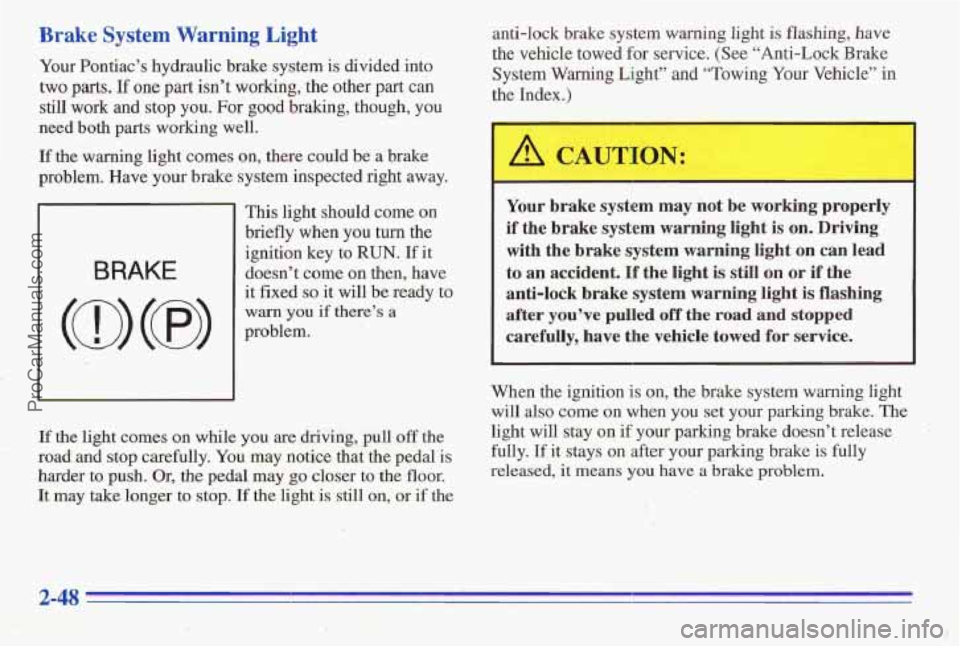
Brake System Warning Light
Your Pontiac's hydraulic brake system is divided into
two pats. If one part isn't working, the other pa;t.can
still work and stop you. For
good braking, though, you
need both parts working well.
If the warning light comes on, there could be a brake
problem. Have your brake system inspected right away.
BRAKE
This light should come on
briefly when you turn the
ignition key to
RUN. If it
doesn't come on then, have
it fixed
so it will be ready to
warn you if there's a
problem.
If the light comes on while you are driving, pull off the
road and stop carefully.
You may notice that the pedal is
harder to push. Or, the pedal may go closer to the floor.
It may take longer to stop. If the light is still on; or if the anti-lock brake system warning light
is flashing,
have
the vehicle towed
for service. (See "Anti-Lock Brake
System Warning Light" and "Towing Your Vehicle" in
the Index.)
A CAUTION: -
~ ~~~~ ~ ~ ~~
Your brake system may not be working properly
if the brake system warning light is on. Driving
with the brake system warning light on can
lead
to an accident. If the light is still on or if the
anti-lock brake system warning light
is flashing
after you've pulled.off the
road and stopped
carefully, have the vehicle towed for service.
When the ignition is on, the brake system warning light
will also come on when you set your
parking brake. The
light will stay on if your parking brake doesn't release
fully.
If it stays on after your parking brake is fdly
released,
it means you have a brake problem.
ProCarManuals.com
Page 118 of 370
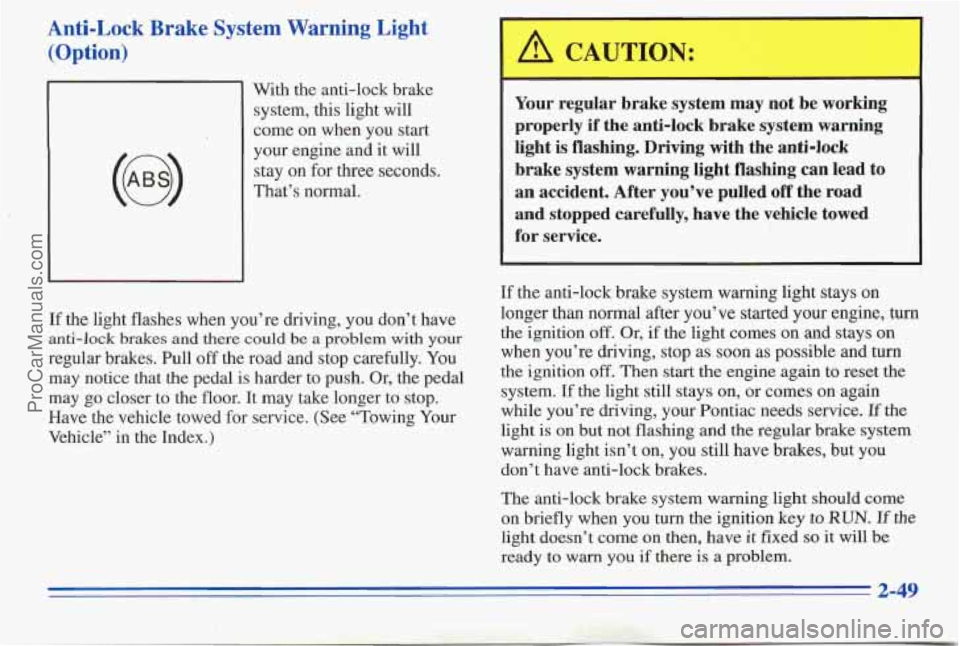
Anti-Lock Brake System Warning Light (Option)
(@)
With the anti-lock brake
system, this light will
come on when you start
your engine and it will
stay
on for three seconds.
That’s normal.
If the light flashes when you’re ( ving, you don’t have
anti-lock brakes and there could be a problem with your
regular brakes. Pull off the road and stop carefully.
You
may notice that the pedal is harder to push. Or, the pedal
may
go closer to the floor. It may take longer to stop.
Have the vehicle towed for service. (See ‘Towing Your
Vehicle’’ in the Index.)
A CAUTION:
I
Your regular brake system may not be working
properly if the anti-lock brake system warning
light is flashing. Driving with the anti-lock
brake system warning light flashing can lead to
an accident. After you’ve pulled
off the road
and stopped carefully, have the vehicle towed
for service.
If the anti-lock brake system warning light stays on
longer than normal after you’ve started your engine, turn
the ignition
off. Or, if the light comes on and stays on
when you’re driving, stop as soon as possible and turn
the ignition
off. Then start the engine again to reset the
system.
If the light still stays on, or comes on again
while you’re driving, your Pontiac needs service.
If the
light
is on but not flashing and the regular brake system
warning light isn’t on, you still have brakes, but you
don’t have anti-lock brakes.
The anti-lock brake system warning light should come
on briefly when you turn
the ignition key to RUN. If the
light doesn’t come on then, have it fixed so it will be
ready to
warn you if there is a problem.
ProCarManuals.com
Page 122 of 370

If the Light Is Flashing
The following may prevent more serious damage to
your vehicle:
If the Light Is On Steady
0 Reduce vehicle speed.
0 Avoid hard accelerations.
0 Avoid steep uphill grades.
0 If towing a trailer, reduce the amount of cargo ,being
hauled as soon as it is possible.
If the light stops flashing and remains
on steady, see “If
the Light Is On Steady” following.
If
the light continues to flash, when it is safe to do so,
stop the vehicle. Put your vehicle in PARK (P). Turn the
key off, wait at least 10 seconds and restart the engine.
If the light remains on steady, see “If the Light Is On
Steady” following.
If the light is still flashing, follow the
previous steps, and drive the vehicle to your dealer or
qualified service center for service.
You may be able to correct the emission system
malfunction by considering the following:
Did you just put fuel into your vehicle?
If
so, reinstall the fuel cap, making sure to fully install
the cap. The diagnostic system can determine if the fuel
cap has been left off or improperly installed.
This will
allow
fuel to evaporate into the atmosphere. A few
driving trips should turn the light off.
Did you just drive through a deep puddle of water?
If
so, your electrical system,.may be wet. The condition
will usually be corrected when the electrical system
dries out. A few driving trips should turn the light
off.
Are you low on fuel?
As your engine starts to
run out of fuel, your engine may
not run as efficiently as designed since
small amounts of
air are sucked into the fuel line causing a misfire. The
system can
detect this. Adding fuel should correct this
condition. Make sure to install the fuel cap properly. It
will take a few driving trips to turn the light off.
2-53
ProCarManuals.com
Page 185 of 370
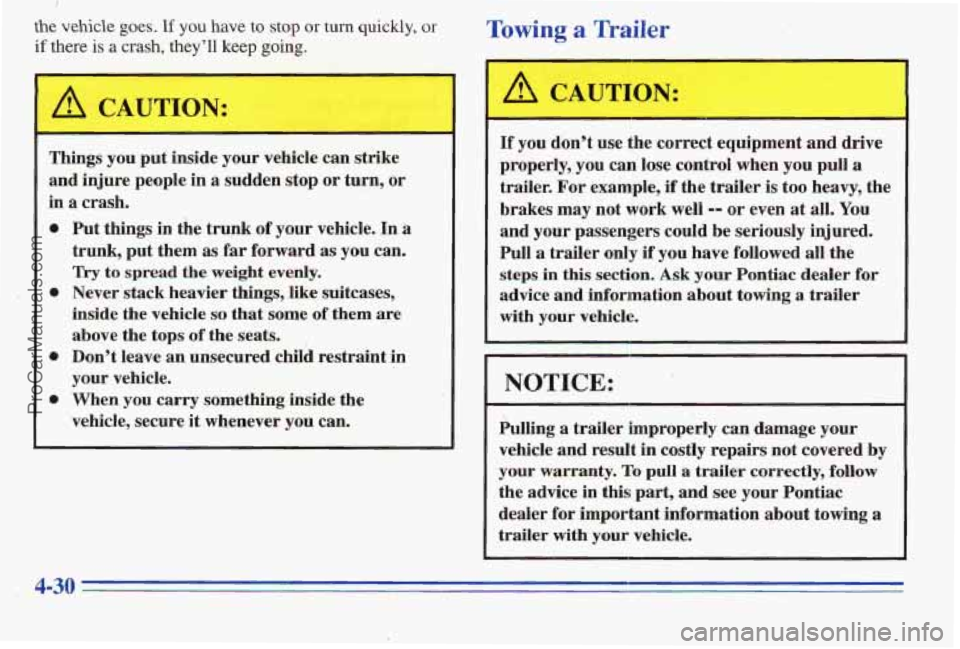
the vehicle goes. If you have to stop or turn quickly, or
if there is a crash, they’ll keep going.
Towing a Trailer
Things you put inside your vehicle can strike
and injure people in a sudden stop or turn, or
in a crash.
0 Put things in the trunk of your vehicle. In a
trunk, put them as far forward as you can.
Try to spread the weight evenly.
inside the vehicle
so that some of them are
above the tops
of the seats.
0 Don’t leave an unsecured chilb restraint in
your vehicle.
0 When you carry something inside the
vehicle, secure
it whenever you can.
0 Never’stack heavier things, like suitcases,
CAUTION:
If you don’t use the correct equipment and drive
properly, you can lose control when you pull
a
trailer. For example, if the trailer is too heavy, the
brakes may not work well
-- or even at all. You
and your passengers could be seriously injured.
Pull
a trailer only if you have followed all the
steps
in this section. Ask your Pontiac dealer for
advice and information about towing a trailer
with your vehicle.
NOTICE:
Pulling a trailer improperly can damage your
vehicle and result in costly repairs not covered
by
your warranty. To pull a trailer correctly, follow
the advice in this part, and see your Pontiac
dealer for important information about towing
a
trailer with your vehicle.
4130 -
ProCarManuals.com
Page 186 of 370
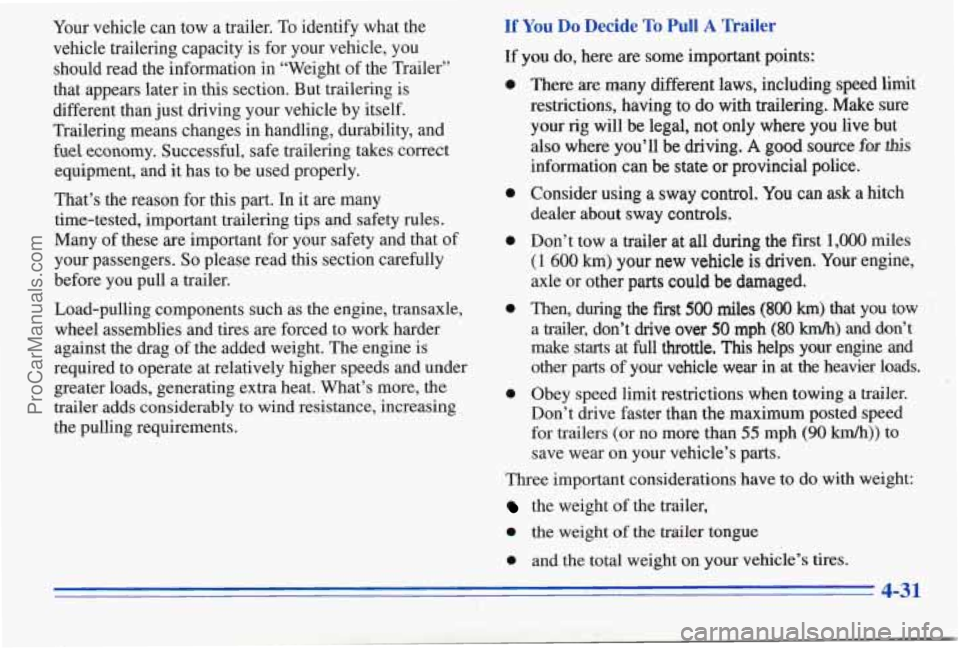
four vehicle can tow a trailer. To identify what the
vehicle trailering capacity is for your vehicle, you
should read the information
in “Weight of the Trailer”
that appears later in this section. But trailering is
different than just driving your vehicle by itself.
Trailering means changes in handling, durability, and
fwl economy. Successful, safe trailering takes correct
equipment, and
it has to be used properly.
That’s the reason for this part. In it are many
time-tested, important trailering tips and safety rules.
Many of these are important for your safety and that
of
your passengers. So please read this section carefully
before you pull
a trailer.
Load-pulling components such as the engine, transaxle,
wheel assemblies and tires are forced to work harder
against the drag
of the added weight. The engine is
required to operate at relatively higher speeds and under
greater loads, generating extra heat. What’s more, the
trailer adds considerably to wind resistance, increasing
the pulling requirements.
If You Do Decide To Pull A Trailer
If you do, here are some important points:
0
0
0
0
0
There are many different laws, including speed limit
restrictions, having
to do with trailering. Make sure
your rig will be legal, not only where you live but
also where you’ll be driving.
A good source fa this
information can be state or provincial police.
Consider using
a sway control. You can ask a hitch
dealer about sway controls.
Don’t tow a trailer
at all during the first 1,000 miles
(1 600 km) your new vehicle is driven. Your engine,
axle
or other parts could be damaged.
Then, during the
fkst 500 miles (800 km) that you tow
a trailer, don’t drive
over 50 mph (80 km/h) and don’t
make starts at
full throttle. This helps your engine and
other parts
of your vehicle wear in at the heavier loads.
Obey speed limit restrictions when towing a trailer.
Don’t drive faster than the maximum posted speed
for trailers (or no more than
55 mph (90 km/h)) to
save wear on your vehicle’s parts.
Three important considerations have to do with weight:
the weight of the trailer,
0 the weight of the trailer tongue
0 and the total weight on your vehicle’s tires.
4-31
ProCarManuals.com